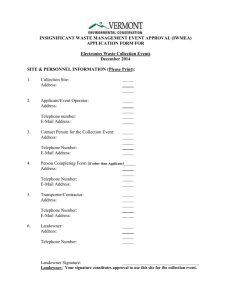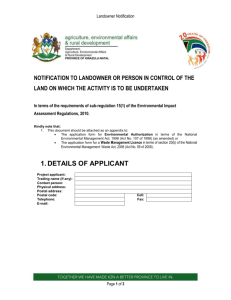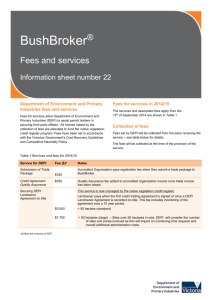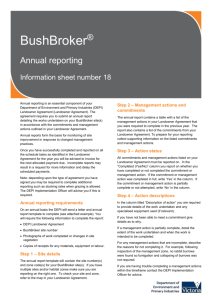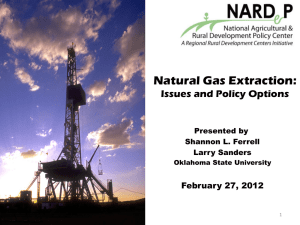Landowner Agreement - Department of Environment, Land, Water
advertisement
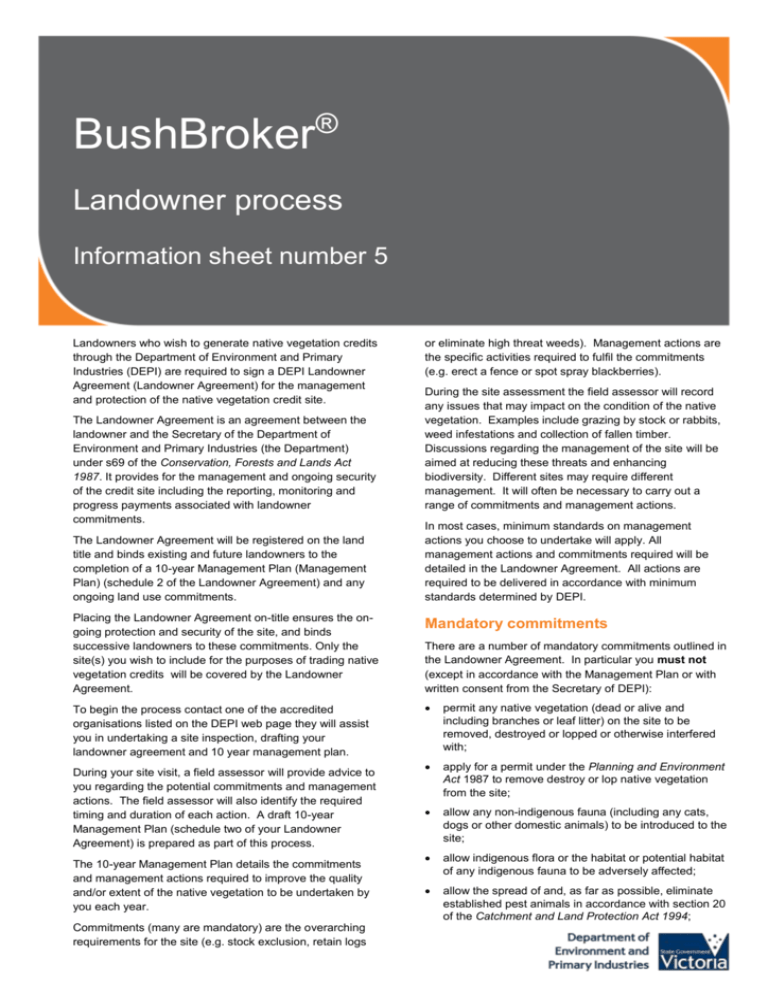
BushBroker® Landowner process Information sheet number 5 Landowners who wish to generate native vegetation credits through the Department of Environment and Primary Industries (DEPI) are required to sign a DEPI Landowner Agreement (Landowner Agreement) for the management and protection of the native vegetation credit site. The Landowner Agreement is an agreement between the landowner and the Secretary of the Department of Environment and Primary Industries (the Department) under s69 of the Conservation, Forests and Lands Act 1987. It provides for the management and ongoing security of the credit site including the reporting, monitoring and progress payments associated with landowner commitments. The Landowner Agreement will be registered on the land title and binds existing and future landowners to the completion of a 10-year Management Plan (Management Plan) (schedule 2 of the Landowner Agreement) and any ongoing land use commitments. or eliminate high threat weeds). Management actions are the specific activities required to fulfil the commitments (e.g. erect a fence or spot spray blackberries). During the site assessment the field assessor will record any issues that may impact on the condition of the native vegetation. Examples include grazing by stock or rabbits, weed infestations and collection of fallen timber. Discussions regarding the management of the site will be aimed at reducing these threats and enhancing biodiversity. Different sites may require different management. It will often be necessary to carry out a range of commitments and management actions. In most cases, minimum standards on management actions you choose to undertake will apply. All management actions and commitments required will be detailed in the Landowner Agreement. All actions are required to be delivered in accordance with minimum standards determined by DEPI. Placing the Landowner Agreement on-title ensures the ongoing protection and security of the site, and binds successive landowners to these commitments. Only the site(s) you wish to include for the purposes of trading native vegetation credits will be covered by the Landowner Agreement. Mandatory commitments To begin the process contact one of the accredited organisations listed on the DEPI web page they will assist you in undertaking a site inspection, drafting your landowner agreement and 10 year management plan. permit any native vegetation (dead or alive and including branches or leaf litter) on the site to be removed, destroyed or lopped or otherwise interfered with; apply for a permit under the Planning and Environment Act 1987 to remove destroy or lop native vegetation from the site; allow any non-indigenous fauna (including any cats, dogs or other domestic animals) to be introduced to the site; allow indigenous flora or the habitat or potential habitat of any indigenous fauna to be adversely affected; allow the spread of and, as far as possible, eliminate established pest animals in accordance with section 20 of the Catchment and Land Protection Act 1994; During your site visit, a field assessor will provide advice to you regarding the potential commitments and management actions. The field assessor will also identify the required timing and duration of each action. A draft 10-year Management Plan (schedule two of your Landowner Agreement) is prepared as part of this process. The 10-year Management Plan details the commitments and management actions required to improve the quality and/or extent of the native vegetation to be undertaken by you each year. Commitments (many are mandatory) are the overarching requirements for the site (e.g. stock exclusion, retain logs There are a number of mandatory commitments outlined in the Landowner Agreement. In particular you must not (except in accordance with the Management Plan or with written consent from the Secretary of DEPI): Landowner process allow the establishment, growth and spread of Regionally Controlled Weeds and eradicate Regionally Prohibited Weeds as required by section 20 of the Catchment and Land Protection Act 1994; condition in perpetuity from the date of commencement of the Landowner Agreement. The field assessor will discuss the fencing options with you. For more information, please refer to BushBroker Information Sheet No. 12 - Standards for management Fencing. allow the growth and spread of any other high threat weeds identified in the second schedule or any new and emerging weeds; allow the application of fertilizer to any part of the site; Weed control erect, place nor permit any structure or dwelling to be placed on the site; Weeds can out-compete native species and reduce the quality of the habitat for native animals. allow (unless required by law) any deterioration in the natural state or in the flow, supply, quantity or quality of any body of water onto or from the site; You are required to control or eradicate weeds beyond your current obligations as established under legislation or as stated in licence or other agreements already in place. allow (unless required by law) any exploration or mining extraction, production of gas, petroleum, minerals or other substances on the site; Many environmental weeds are not listed under legislation, but still pose a high threat in native vegetation. allow (unless required by law) any transmission lines or other services or works on the site; permit the removal, introduction or disturbance of any soil, rocks, or other minerals or the construction of dams; permit the subdivision of any part of the site; or permit the operation of any trade, industry or business, the recreational use of trail bikes or four wheel drive vehicles, the accumulation of rubbish or the storage of any materials or any other activities not consistent with the purposes of the Landowner Agreement; additional mandatory commitments may apply. Management actions Grazing In most cases complete stock exclusion is required. In some cases, particularly in grasslands, grazing may be appropriate at an agreed timing and rate. To reduce the risk of introducing and spreading weeds, grazing management will require livestock to be kept in a holding paddock outside the site for a minimum period of 24 hours before entry. Management of other grazing threats by introduced animals (e.g. rabbits) is required. The field assessor will discuss the range of management options available with you. For more information, please refer to BushBroker Information Sheet No. 13 – Standards for management - Ecological grazing and BushBroker Information Sheet No. 7 - Standards for management Rabbits. Fencing Fencing is generally required for stock exclusion or managing grazing levels in your site. You will be required to maintain both new and existing fencing in a stock proof www.depi.vic.gov.au Weeds considered to be a high threat will need to be managed in order to protect and improve biodiversity. You are also expected to control any new and emerging weeds which appear on the site. High threat species will be identified during the site assessment. The field assessor cannot provide any advice regarding the selection and use of herbicides. For more information on weed control, please refer to BushBroker Information Sheet No. 8 – Standards for management - Weeds. Supplementary planting and revegetation Where native plant species have been lost or cleared from a site, or there are significant gaps in the vegetation, supplementary planting or revegetation of indigenous (local native) species may improve the biodiversity of your site. The field assessor will inform you if supplementary planting or revegetation is recommended (these actions are generally recommended for woody vegetation only) and you can choose whether to include it in your draft Landowner Agreement. If you do, the field assessor will work with you to develop a species list and survival targets appropriate for your site. All tube-stock or seed used for supplementary planting or revegetation are to be sourced from species indigenous to the site. Guidance on appropriate methods of collection will be available from the field assessor. Permits may be required for collection on public land. For more information please refer to BushBroker Information Sheet No. 9 - Standards for management Supplementary planting and BushBroker Information Sheet No. 10 – Standards for management - Revegetation. Ecological burning Nearly all Victorian vegetation types are adapted to periodic burning by fire. Fire is critical to the survival and recruitment of many native plant species. Ecological burning may be a useful tool to increase biodiversity, particularly in areas where fire may have been Landowner process absent for many decades. However, in general, fire will not be recommended as a management tool due to the associated risks and uncertain outcomes. If you wish to use fire as a management tool seek advice from a DEPI Project Officer who will determine the level of regeneration of fire–dependent plant species, taking into account any other threats to biodiversity observed on the site. For more information on ecological burning, please refer to BushBroker Information Sheet No. 14 – Standards for management - Ecological burning. Fire prevention You are required to take all reasonable steps to prevent fire on your land, provided these steps do not conflict with other commitments under the Landowner Agreement. Control of various environmental weeds may assist reduce fuel loads. Where possible, firebreaks should be established outside the site and slashed, rather than cultivated or sprayed, to minimise disturbance to native vegetation. Fire prevention activities are required to comply with local government planning controls. Ecological thinning Ecological thinning is the selection and removal of some trees or stems to allow others to grow and reach their mature size faster. In some cases ecological thinning of eucalypts will be recommended to help improve the structure and diversity of your site(s). Ecological thinning is typically applied to sites where there are trees of young, even-aged regeneration, often resulting from an unnatural disturbance event (e.g. timber harvesting) that are competing for resources and growth is suppressed. Some self-thinning will occur naturally but at very slow rates. Some fire-sensitive forest types (e.g. Mountain Ash) will often produce even-aged regeneration with few scattered mature survivors. Ecological thinning is not usually required to improve the health and condition of these natural stands. Conditions will apply to ecological thinning proposals. For more information refer to BushBroker Information Sheet No. 15 – Standards for management – Ecological thinning. Native vegetation credits available through the Landowner Agreement The number and type of native vegetation credits that will be generated are detailed in Tables one and two of the Landowner Agreement (Schedule two). Table one summarises the key details of the site assessed by the field assessor. www.depi.vic.gov.au Monitoring and reporting Once the Landowner Agreement has been signed, landowners are required to submit an annual report to DEPI, detailing the actions undertaken during the preceding 12 months and describing progress towards targets. DEPI will monitor a number of Landowner Agreements annually through site visits. If the commitments or management actions are not being met, DEPI will work with the landowner to remedy the situation. If this fails, subsequent payments may be withheld until the necessary works are completed. Non-compliance with the Landowner Agreement may result in a requirement for payments received by the landowner and associated costs being paid back to DEPI. For more information on annual reporting, refer to BushBroker Information Sheet No. 18 – Annual reporting. Payment schedule You will be paid percentages of the total agreed price over 10 years, as per the third schedule in your Landowner Agreement. After submitting your annual report to DEPI and having completed all your management actions for the year, you may then invoice DEPI for the appropriate amount. For more information please refer to BushBroker Information Sheet No. 18 – Annual reporting Financial implications Please consult your tax adviser about any tax implications before entering into a Landowner Agreement. Additionally, some rating authorities may wish to revalue the property once a Landowner Agreement has been registered on-title. Check with your local council or a qualified land valuer for more information on the effect of the Landowner Agreement on your rates. Landowner Agreement amendment or removal The Secretary of the Department will consider changes to a Landowner Agreement only if equivalent or better biodiversity outcomes will be achieved. Amendments must be in writing and agreed to by both parties. Re-negotiation of the payments for management services will not be possible. Only in unusual circumstances can a Landowner Agreement be removed. The Landowner Agreement provides permanent protection of conservation values on the site. Landowner process In the event of the termination of a Landowner Agreement, there is a requirement to create a replacement offset for the cleared site if any credits have been reassigned on the native vegetation credit register. Amendment or removal of a Landowner Agreement must be in accordance with s76 of the Conservation Forests and Lands Act 1987. Further information For further information on BushBroker or the native vegetation credit register, please contact the Department of Environment and Primary Industries Customer Service Centre on 136 186 or visit the DEPI website at: www.depi.vic.gov.au/bushbroker. All BushBroker Information Sheets are available on the website. Health and safety You are responsible for ensuring all works required in implementing the management actions are conducted in a safe manner and comply with the lawful requirements of any Authority, and with all Acts, regulations and other laws which may be applicable to the Landowner Agreement. To determine whether there are any underground pipes or cables on your property, you may wish to consider calling 1100 - “Dial before you dig”. This is a free referral service from anywhere in Australia. © The State of Victoria Department of Environment and Primary Industries Melbourne 2014 This work is licensed under a Creative Commons Attribution 3.0 Australia licence. You are free to re-use the work under that licence, on the condition that you credit the State of Victoria as author. The licence does not apply to any images, photographs or branding, including the Victorian Coat of Arms, the Victorian Government logo and the Department of Environment and Primary Industries logo. To view a copy of this licence, visit http://creativecommons.org/licenses/by/3.0/au/deed.en ISBN 978-1-74287-692-4 (online – set) www.depi.vic.gov.au Accessibility If you would like to receive this publication in an alternative format, please telephone DEPI Customer Service Centre 136 186, email customer.service@depi.vic.gov.au, via the National Relay Service on 133 677 www.relayservice.com.au. This document is also available on the internet at www.depi.vic.gov.au Disclaimer This publication may be of assistance to you but the State of Victoria and its employees do not guarantee that the publication is without flaw of any kind or is wholly appropriate for your particular purposes and therefore disclaims all liability for any error, loss or other consequence which may arise from you relying on any information in this publication.
